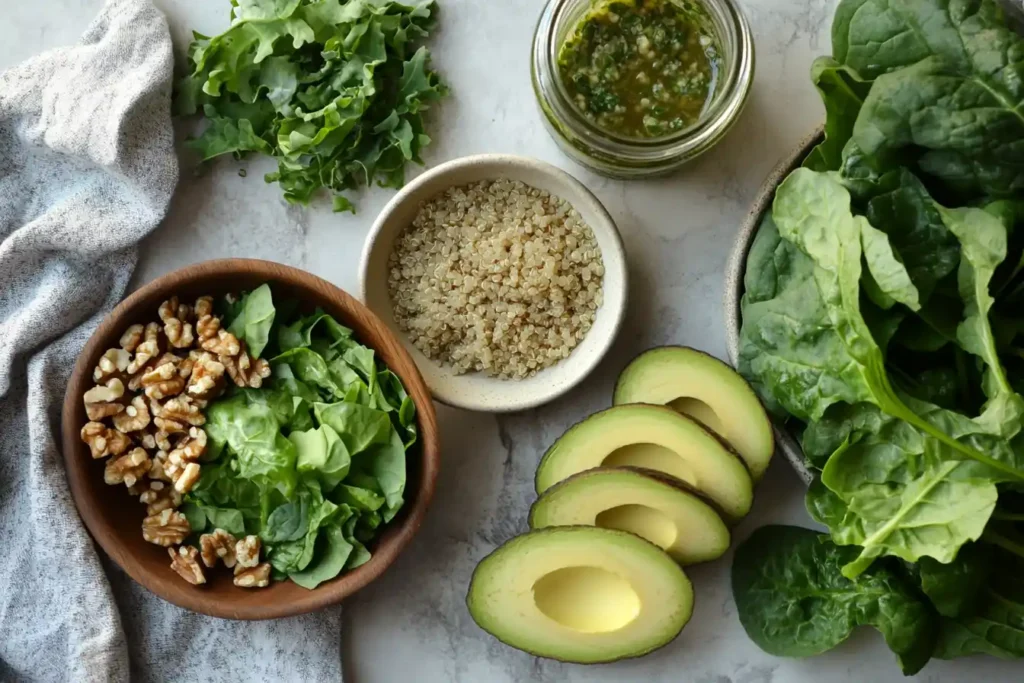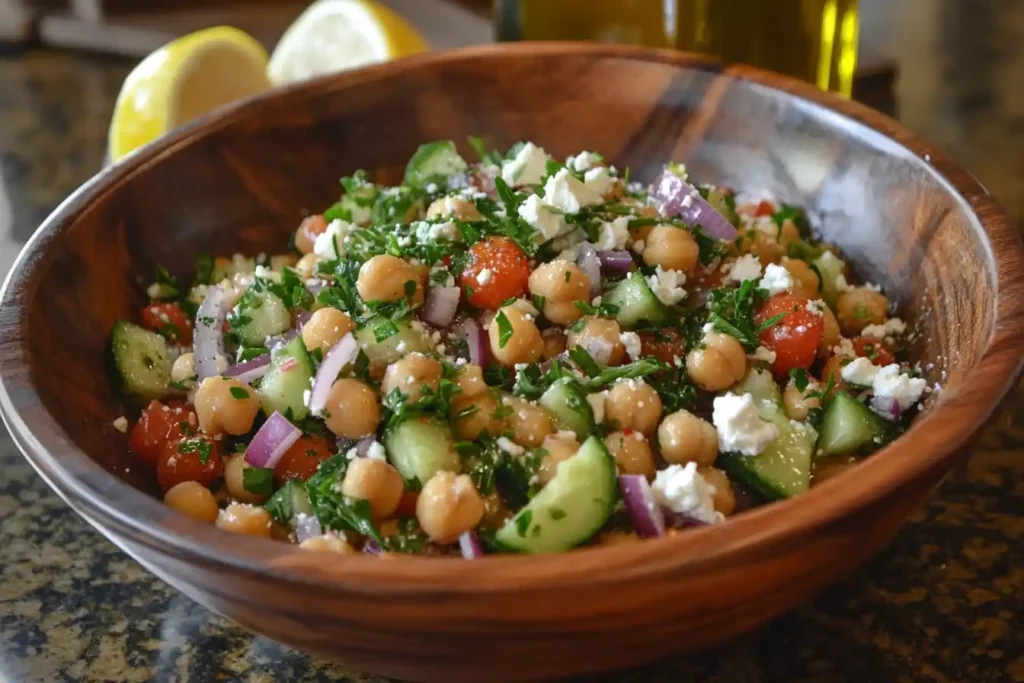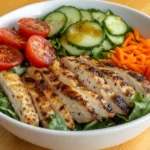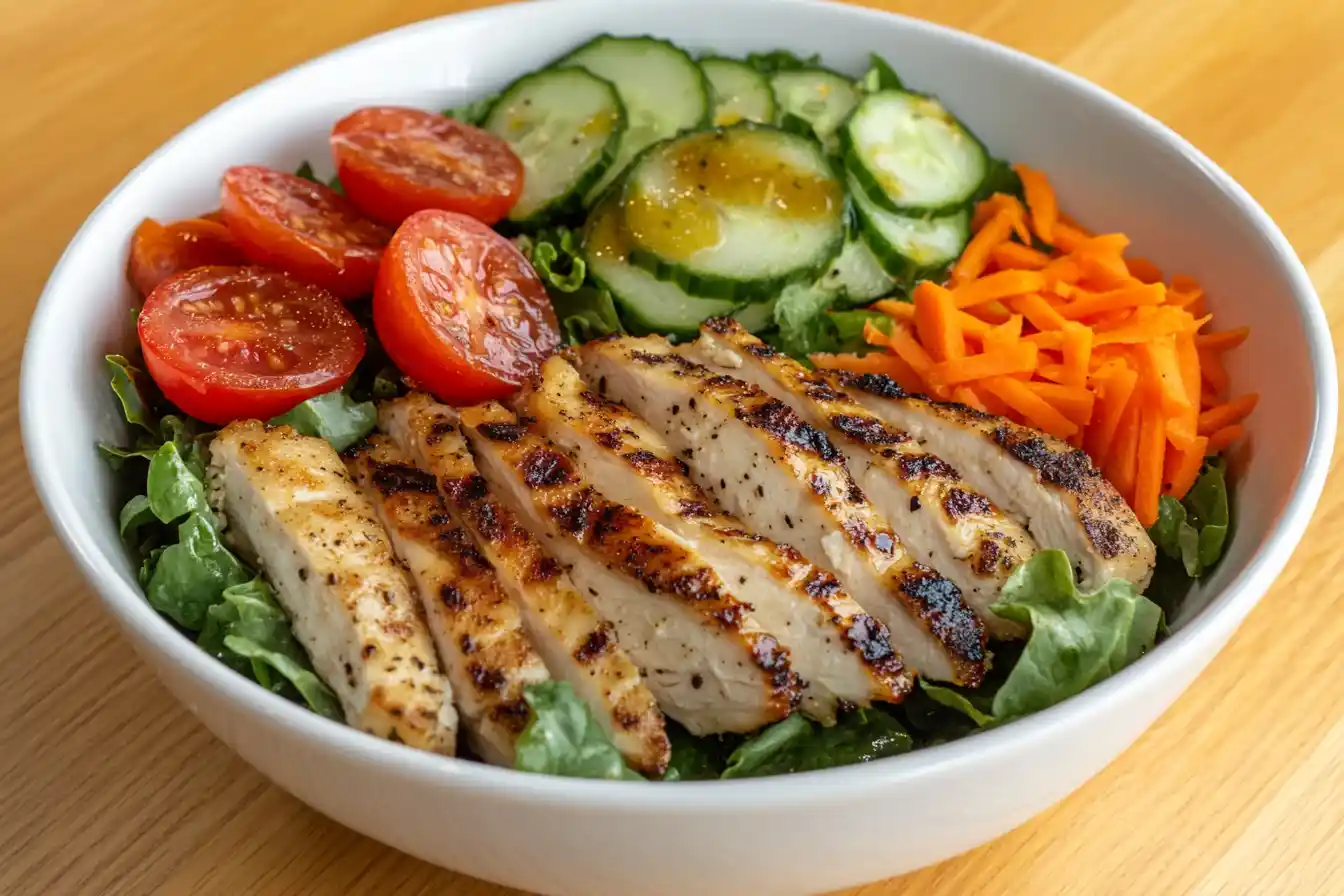Salads are often synonymous with healthy eating, but not all salads are created equal. In this detailed guide, we’ll answer the question: What is the healthiest salad you can eat? We’ll explore unique combinations of ingredients, dressing choices, and various tips to build a truly nutritious salad. Whether you are looking for weight loss, better overall health, or simply a more balanced diet, this article will serve as a comprehensive resource.
What Makes a Salad Healthy?
To determine what is the healthiest salad you can eat, it is essential to understand the main characteristics that contribute to a healthy salad. Typically, the healthiest salads include fresh, colorful vegetables, lean protein, and healthy fats, all while being low in processed ingredients.
Nutrient-Dense Vegetables
When building a healthy salad, the choice of vegetables plays a significant role in its nutritional value. The most nutritious salads include a wide variety of vegetables, particularly those rich in antioxidants, fiber, vitamins, and minerals.
- Leafy Greens: Spinach, kale, arugula, and Swiss chard are excellent choices. They are rich in iron, calcium, and vitamins A, C, and K.
- Colorful Vegetables: Add a variety of colors to your salad to boost its nutritional profile. Tomatoes, bell peppers, carrots, cucumbers, and radishes are great for adding flavor, crunch, and essential nutrients.
- Cruciferous Vegetables: Broccoli, cabbage, and Brussels sprouts add an additional layer of fiber and phytonutrients that are beneficial to health.
Learn more about the benefits of cruciferous vegetables to improve your salad’s nutritional value.
Adding Protein to Boost Nutrition
A healthy salad also needs a protein source to ensure you stay satisfied for longer. Proteins are essential for muscle building, immunity, and overall body function.
- Lean Meats: Chicken breast and turkey are popular choices for salads.
- Plant-Based Proteins: Beans, chickpeas, edamame, and lentils are great for vegetarians or anyone looking to add a plant-based protein source.
- Fish and Seafood: Salmon, shrimp, and tuna are packed with omega-3 fatty acids and high-quality protein.
For additional tips on incorporating protein, check out this resource on protein sources and health benefits.
The Role of Healthy Fats
Including healthy fats in your salad helps to absorb the fat-soluble vitamins and adds to the overall satiety of the meal.
- Avocado: Rich in monounsaturated fats, avocados provide creaminess and nutrients.
- Nuts and Seeds: Almonds, walnuts, sunflower seeds, or chia seeds add texture and healthy omega-3s.
- Olive Oil: Used as a salad dressing base, extra virgin olive oil is an excellent source of healthy fat.
Exemple of healthiest salad
This Ultimate Superfood Salad is a harmony of fresh, wholesome ingredients crafted to nourish your body and invigorate your senses. Featuring tender baby kale and crisp watercress as the leafy base, it’s elevated with nutty freekeh and naturally sweet roasted sweet potatoes. Crunchy radishes and creamy avocado add layers of texture, while sunflower seeds and dried cranberries bring the perfect balance of savory and sweet. Drizzled with a light, tangy flaxseed oil dressing, this salad is a powerhouse of essential nutrients, antioxidants, and healthy fats. Ideal as a refreshing lunch, a light dinner, or a vibrant addition to any meal, it’s the ultimate way to fuel your day with flavor and vitality.
Ingredients
| Ingredient | Description |
|---|---|
| 3 cups baby kale | A tender leafy green rich in iron, vitamin C, and powerful antioxidants. |
| 1 cup watercress | Peppery and packed with calcium and nutrients that support bone health. |
| ½ cup cooked freekeh | A fiber-rich ancient grain with a smoky flavor that adds texture and nutrition. |
| ½ cup thinly sliced radishes | Adds a crisp texture and spicy bite with loads of vitamin C. |
| ½ cup roasted sweet potato cubes | Provides natural sweetness and a boost of beta-carotene for healthy skin and vision. |
| 1 small avocado (cubed) | Creamy, nutrient-dense, and packed with heart-healthy monounsaturated fats. |
| 2 tablespoons sunflower seeds | Crunchy and full of vitamin E, magnesium, and healthy fats. |
| 2 tablespoons dried cranberries | Naturally sweet with a tangy twist, loaded with antioxidants. |
| ¼ cup crumbled blue cheese | A bold, creamy addition that adds richness and tangy flavor. |
| 2 tablespoons flaxseed oil | A plant-based source of omega-3 fatty acids to promote heart and brain health. |
| 1 tablespoon balsamic vinegar | Adds a sweet and tangy flavor to complement the salad ingredients. |
| 1 teaspoon honey | A natural sweetener to balance the acidity of the dressing. |
| Salt and freshly cracked black pepper | Essential for seasoning and enhancing the flavors of the dish. |
Preparation Steps
- Prepare the Greens:
Rinse and pat dry the baby kale and watercress. Place them in a large salad bowl as the base for your salad. - Cook the Freekeh:
Rinse ½ cup of freekeh under cold water. Cook in 1½ cups of water or broth for about 20 minutes, or until tender. Drain and cool before adding to the salad. - Roast the Sweet Potato:
Peel and dice a small sweet potato into cubes. Toss with olive oil and a pinch of salt, then roast at 375°F (190°C) for 25 minutes until tender and slightly caramelized. - Assemble the Salad:
Layer the cooked freekeh, roasted sweet potato cubes, sliced radishes, avocado, sunflower seeds, dried cranberries, and crumbled blue cheese on top of the greens. - Make the Dressing:
In a small bowl, whisk together the flaxseed oil, balsamic vinegar, honey, salt, and black pepper until smooth. - Toss and Serve:
Drizzle the dressing over the salad and gently toss to combine. Serve immediately for a vibrant, nutrient-dense meal that’s perfect for any time of day.
This superfood-packed salad is a powerhouse of flavor, texture, and nutrition. Loaded with vitamins, healthy fats, and protein, it’s an ideal choice for a satisfying and wholesome meal!
Tips for Crafting the Healthiest Salad
Building the healthiest salad you can eat involves considering your choice of ingredients, the portion size, and balancing flavors.
Focus on Fresh, Seasonal Ingredients
Freshness matters when making a healthy salad. Seasonal produce is more likely to contain higher nutrient levels compared to produce that is stored or transported over long distances.
Avoid High-Calorie Additions
Some common salad toppings may increase calorie content without offering much nutritional benefit.
- Skip Croutons: Often made with refined flour and added oils, croutons can be replaced with roasted chickpeas for a healthier crunch.
- Cheese in Moderation: Cheese provides calcium but can be high in calories and saturated fat. Choose small amounts of goat cheese or feta for flavor without overindulgence.
Choose a Healthy Salad Dressing

Dressings can make or break your salad’s healthfulness. Instead of creamy store-bought dressings, try making your own at home with wholesome ingredients.
- Simple Vinaigrette: A mixture of extra virgin olive oil, balsamic vinegar, Dijon mustard, and a touch of honey is healthier compared to sugar-laden store-bought dressings.
- Greek Yogurt-Based Dressing: Greek yogurt, lemon juice, garlic, and herbs can provide a creamy alternative to ranch dressing without excess calories.
Explore easy salad dressing recipes that will elevate your salad without compromising its health value.
Types of Healthy Salads You Can Eat
There are many different types of salads that fit into the category of “healthiest salads.” Here, we explore a few specific examples that provide balanced nutrition.
Mediterranean Chickpea Salad

This salad combines chickpeas, cucumber, red onion, bell peppers, and cherry tomatoes. The dressing consists of olive oil, lemon juice, and oregano. Chickpeas are a great source of plant-based protein, fiber, and antioxidants, making this salad a great option.
Key Benefits
- High fiber content helps maintain a healthy digestive system.
- Provides healthy fats from olive oil and seeds.
Spinach and Quinoa Salad
Spinach and quinoa make a dynamic pair that is nutrient-dense and filling. Add pomegranate seeds, chopped walnuts, and a simple lemon vinaigrette for flavor.
Key Benefits
- Quinoa provides all nine essential amino acids.
- Spinach offers iron, calcium, and other vitamins.
- Pomegranate seeds are packed with antioxidants.
Grilled Chicken Caesar Salad (Healthy Version)
This healthier take on the classic Caesar salad features grilled chicken, romaine lettuce, shaved Parmesan, and a Greek yogurt-based Caesar dressing.
Key Benefits
- Provides lean protein from grilled chicken.
- Romaine lettuce is high in vitamin A and folate.
- Greek yogurt adds probiotics for gut health.
Avoiding Common Salad Pitfalls
Not all salads are as healthy as they seem. Many commercially available salads come loaded with unhealthy toppings or dressings that can make them higher in calories than expected.
Avoid Sugary Dressings
Dressings like honey mustard, French, and Thousand Island often contain added sugars, which add empty calories without nutritional benefits.
Be Wary of Fried Ingredients
Fried chicken strips, wonton strips, and bacon bits are common culprits that increase the calorie count without providing significant nutritional value. Instead, opt for grilled or baked ingredients.
Limit Portion Size of Calorie-Dense Additions
Ingredients such as cheese, nuts, and dried fruits are nutrient-dense but also high in calories. Use them in moderation to maintain the balance between nutrients and calorie intake.
Best Dressings for the Healthiest Salads
Dressings are the finishing touch that can elevate your salad while significantly influencing its nutritional value. Choosing homemade dressings or carefully selected store-bought versions ensures your salad remains healthy and free from unnecessary additives, sugars, and unhealthy fats. A great dressing complements the flavors of your ingredients and helps maximize nutrient absorption, especially fat-soluble vitamins like A, D, E, and K. Below are some of the healthiest options to consider, each adding a unique flavor profile to your salads.
Vinaigrette-Based Dressings
Vinaigrettes are light, tangy, and typically lower in calories than cream-based dressings. Their simple ingredient list makes them an easy, go-to choice for health-conscious salad lovers.
- Balsamic Vinaigrette: Combining balsamic vinegar, extra virgin olive oil, and Dijon mustard, this dressing offers a perfect balance of sweetness and acidity. Add a touch of honey or maple syrup for a slight hint of sweetness, or freshly cracked black pepper for a bold finish. Balsamic vinaigrette pairs beautifully with leafy greens, roasted vegetables, and even fruit-based salads like those with strawberries or pears.
- Lemon Herb Vinaigrette: Made with freshly squeezed lemon juice, olive oil, minced garlic, and herbs like oregano or parsley, this dressing is both refreshing and zesty. It’s particularly suited for Mediterranean-inspired salads with ingredients like cucumbers, tomatoes, and feta cheese.
Greek Yogurt Dressings
Greek yogurt-based dressings offer a creamy texture and a boost of protein without the heaviness of mayonnaise or cream. They are versatile, nutritious, and easy to customize.
- Greek Yogurt Ranch: This lighter version of the classic ranch dressing uses Greek yogurt as a base, blended with garlic, parsley, dill, and a splash of apple cider vinegar. It’s an excellent dip for veggie-packed salads or raw vegetable platters.
- Tzatziki-Style Dressing: Inspired by the Greek classic, this dressing combines Greek yogurt with grated cucumber, fresh mint, lemon juice, and garlic. It has a tangy and cooling effect, making it ideal for salads with spicy grilled chicken or falafel.
Tahini-Based Dressings
Tahini, a paste made from ground sesame seeds, is not only rich in calcium and healthy fats but also provides a creamy, nutty flavor that enhances a variety of salads.
- Lemon Tahini Dressing: A simple combination of tahini, lemon juice, garlic, and water creates a rich yet low-fat dressing. For added complexity, try blending in a pinch of cumin or smoked paprika. This dressing pairs well with hearty salads featuring kale, roasted sweet potatoes, or chickpeas.
- Spicy Tahini Dressing: For an extra kick, mix tahini with lime juice, sriracha, a dash of sesame oil, and a little honey. This spicy-sweet dressing works wonders on salads with Asian-inspired flavors, such as those with shredded cabbage, edamame, and mandarin oranges.
By choosing these wholesome, flavor-packed dressings, you can enhance your salads while staying on track with your health goals. Experimenting with these options ensures variety and keeps your salads both delicious and nutritious.
Frequently Asked Questions (FAQs)
What Type of Salad is the Healthiest?
Absolutely! Eating the healthiest salad daily can dramatically enhance your intake of fiber, vitamins, and minerals, supporting overall health and vitality. By incorporating a wide range of ingredients, you can ensure a diverse nutrient profile. Rotating between proteins like grilled shrimp, hard-boiled eggs, or beans keeps your salads interesting and prevents dietary monotony. It’s vital, however, to strike a balance. Adding too many high-calorie dressings, fried toppings, or processed items can reduce the benefits of even the healthiest salad you choose to eat.
To keep things exciting and nourishing, explore seasonal produce, introduce new textures like roasted seeds or raw veggies, and experiment with flavorful homemade dressings.Salads like a Mediterranean Chickpea Salad, loaded with fiber and healthy fats, or a Spinach and Quinoa Salad packed with protein and essential amino acids, are prime examples of a well-balanced and nutritious meal. This strategy guarantees every salad is both nutritious and enjoyable.
Is it Healthy to Eat a Salad Every Day?
Absolutely! Consuming a salad daily can dramatically increase your intake of fiber, vitamins, and minerals, supporting overall health. Including diverse ingredients in your daily salads ensures you’re getting a wide range of nutrients. For instance, rotating between proteins like grilled shrimp, hard-boiled eggs, or beans can prevent monotony and address different dietary needs. However, balance is key. Overloading salads with high-calorie dressings, fried toppings, or processed ingredients can counteract their benefits. To keep your salads healthy and exciting, experiment with seasonal produce, new textures, and creative dressing recipes. This approach keeps your meals fresh, flavorful, and packed with goodness.
What to Avoid in Salad for Weight Loss?
When aiming to create the healthiest salad you can eat for weight loss, it’s crucial to avoid certain high-calorie additions. Ingredients like croutons, fried chicken strips, and candied nuts often introduce unnecessary fats and sugars that derail your goals. Likewise, dressings with excessive sugar or oil can turn a nutritious meal into a calorie-dense option. Instead, focus on nutrient-dense, low-calorie components. Lean proteins such as turkey, tofu, or lentils promote satiety, while hydrating vegetables like cucumbers, zucchini, and leafy greens add volume without adding calories.
What is the Number One Healthiest Salad Dressing?
A homemade vinaigrette using extra virgin olive oil and fresh lemon juice is often seen as the key to creating the healthiest salad you can eat. This simple yet highly versatile dressing not only enhances the flavors of your salad but also avoids unnecessary additives. Olive oil provides monounsaturated fats that support heart health and combat inflammation, while lemon juice delivers a zesty tang along with a rich dose of vitamin C. For a burst of extra flavor, try adding a pinch of salt, a sprinkle of pepper, or a spoonful of Dijon mustard or minced garlic.
Not only does this dressing pair well with a variety of salads, but it also aids in absorbing essential nutrients like beta-carotene and vitamin K, making every bite of your healthiest salad both nourishing and delicious.
Conclusion
Crafting the healthiest salad you can eat is an art that balances nutrition, flavor, and personal preferences. By choosing fresh, nutrient-dense vegetables, lean protein sources, and healthy fats, you can create meals that not only support your health goals but also delight your taste buds. Remember to keep your salads vibrant with a variety of colors, textures, and homemade dressings that elevate the overall experience.
Additionally, experimenting with global flavors and seasonal ingredients can keep your salad game exciting and inspiring. Whether you’re preparing a quick weekday lunch or a gourmet dish for special occasions, salads offer endless opportunities for creativity and nourishment. Take these tips and ideas into your kitchen, and discover how versatile and satisfying a truly healthy salad can be!
Print
Ultimate Superfood Salad for Maximum Nutrition
- Total Time: 40 minutes
- Yield: 2 servings 1x
Description
This Ultimate Superfood Salad is a nourishing blend of powerhouse ingredients designed to fuel your body and satisfy your taste buds. With a base of baby kale and watercress, fiber-rich freekeh, antioxidant-packed vegetables, and a heart-healthy flaxseed oil dressing, it’s the perfect meal for anyone seeking a vibrant, nutrient-dense dish.
Ingredients
3 cups baby kale
1 cup watercress
½ cup cooked freekeh
½ cup thinly sliced radishes
½ cup roasted sweet potato cubes
1 small avocado, cubed
2 tablespoons sunflower seeds
2 tablespoons dried cranberries
¼ cup crumbled blue cheese
2 tablespoons flaxseed oil
1 tablespoon balsamic vinegar
1 teaspoon honey
Salt and freshly cracked black pepper, to taste
Instructions
-
Prepare the Greens: Rinse and dry the baby kale and watercress. Place in a large salad bowl.
-
Cook the Freekeh: Rinse ½ cup freekeh. Simmer in 1½ cups water or broth for about 20 minutes. Drain and let cool.
-
Roast the Sweet Potato: Dice a small sweet potato, toss with olive oil and salt, and roast at 375°F (190°C) for 25 minutes.
-
Assemble the Salad: Top greens with freekeh, roasted sweet potato, radishes, avocado, sunflower seeds, cranberries, and blue cheese.
-
Make the Dressing: Whisk flaxseed oil, balsamic vinegar, honey, salt, and pepper in a small bowl.
-
Toss and Serve: Drizzle dressing over salad and gently toss. Serve immediately.
Notes
For a vegan version, omit blue cheese or use a plant-based alternative.
Substitute quinoa or brown rice for freekeh if gluten-free is needed.
Add grilled salmon or chickpeas for extra protein.
Store dressing separately if meal-prepping to keep greens crisp.
- Prep Time: 15 minutes
- Cook Time: 25 minutes
- Category: Dinner
- Method: Tossing
- Cuisine: Modern American
Nutrition
- Serving Size: 1 large bowl (1/2 of recipe)
- Calories: 480 kcal
- Sugar: 10g
- Sodium: 360mg
- Fat: 30g
- Saturated Fat: 5g
- Unsaturated Fat: 22g
- Trans Fat: 0g
- Carbohydrates: 42g
- Fiber: 9g
- Protein: 10g
- Cholesterol: 10mg
Keywords: healthiest salad, superfood salad recipe, kale watercress salad, anti-inflammatory salad, high fiber salad, flaxseed dressing

